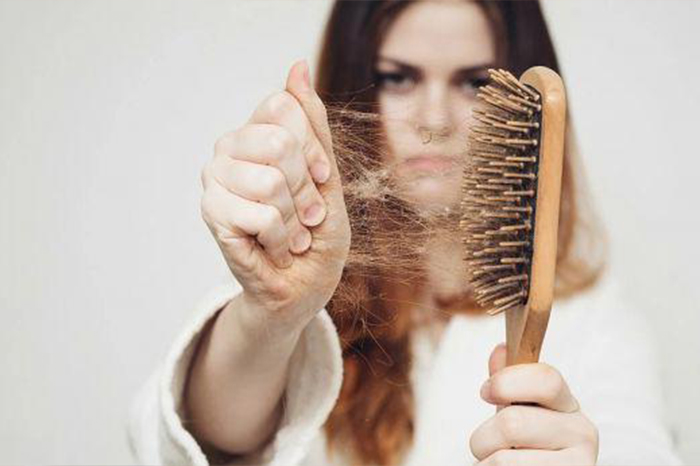Dense, shiny, strong, long. Such hair has long been considered a symbol of health and beauty. However, not everyone is so lucky that their hair looks like a shiny magazine all their life. If you have a pillow full of looking hair in the morning, or you’re combing every tuft with every comb, it’s time to act.
Hair loss
Hair loss and its growth cycle
Hair loss is quite a natural phenomenon. Each of us usually loses about 100 of them every day. If more, the hair begins to thin, and in this case, we are talking about alopecia, which is a technical term for hair loss. How could this happen?
Hair growth has its own exact cycle, which consists of three stages. The first phase is called anagen, lasts 2-7 years, and is the period when the hair is active and growing. This is followed by the catagen transition phase. It lasts for several weeks and the dermal papilla that nourishes the hair dies. This is followed by a final phase of several months, the so-called telogen phase when the hair rises up and eventually falls out. If the hair is in the correct proportions in the anagen and telogen phases, then the amount of hair is preserved. If the amount of hair in the telogen phase prevails, the hair begins to shrink slowly.
The causes of hair loss vary depending on the type of alopecia.
The two most common types of baldness are androgenic alopecia and chronic diffuse alopecia. Androgenic alopecia is caused by the action of testosterone, as well as age and heredity. Although male sex hormones are involved in its production, it also occurs in women. In men, this is usually manifested by a displacement of the anterior hairline (corners) and hair loss on the crown (wheel). In women, it begins with the expansion of the central pathway, then the hair on the scalp gradually things, so that the skin shines through.
Chronic diffuse alopecia is a term used to describe uniform baldness that occurs, for example, seasonally, with certain diseases, with the use of certain medications, often after childbirth, with the weakening of the body, unbalanced nutrition, increased stress, etc. the cause may often be unclear.
Another type of alopecia is focal hair loss (focal alopecia), in which hair falls out in clearly demarcated areas. It is often found in preschool children. This is an autoimmune disease, the treatment of which is in the hands of a specialist.
Hair loss
What can you do with your own hair?
Strong hair requires a balanced and varied diet with all the necessary nutrients (carbohydrates, fats, proteins), rich in vitamins and minerals (B vitamins, iron, selenium, zinc, phosphorus). According to some reports, 40% of women with alopecia suffer from anemia, so iron intake is important. No less important is a sufficient amount of protein. In case of an event. To switch to a lean diet, protein needs to come from other sources, ideally, it is better to consult with a nutritionist.
Choose hair care according to your hair type and the problems you are prone to (oily hair, thin hair, sensitive scalp, dandruff, etc.)
Use cooler air to blow dry your hair. Ideally, let your hair dry freely without using a hairdryer.
Wet hair is very fragile, so gently wipe them with a towel, do not rub it. If you want to comb them, then with a fine comb.
Do not tighten the owner’s hair, combed in a ponytail.
Use hair dyes that do not irritate the scalp. If your skin turns red during the application, change the brand.
Trim the ends regularly so that the hair does not get disheveled along the entire length.
The state of the hair is also affected by the psyche, so it’s enough to relax and pay attention to what you like.
In case of serious problems or concerns, consult a doctor.
What to choose at the pharmacy for hair loss?
Over-the-counter Hair Loss medications
External use: Over-the-counter medications for hair loss (solutions) contain the active substance minoxidil, which is the most widely used substance for this indication worldwide. When applying, always follow the instructions on the package and make sure that the product you choose is intended for men or women – some products may have a stronger composition that is not suitable for women (5% minoxidil).
Internal use – capsules containing vitamins, amino acids (methionine, cysteine), and other substances against hair loss. They can also be used for nail growth disorders. D play diet – A common cause of hair loss is poor nutrition, so you can try any dietary supplements that can help alleviate your symptoms. Dietary supplements designed to maintain the normal condition of hair and nails usually contain B vitamins, biotin, zinc, amino acids, plant extracts, or, for example, medicinal yeast.
Dermocosmetics – dermo-cosmetics, that is, shampoos, tonics, masks, and serums, occupy an indispensable place among hair growth enhancers, which use a wide range of active ingredients with various mechanisms of action from supporting blood circulation of the scalp to stimulating hair follicle stem cells (caffeine, stemoxidine, aminexyl, residency). In addition, these products have very pleasant cosmetic properties, for example, shampoos from this category wash the hair very carefully, but effectively, the hair remains soft and elastic after washing, and their fragility decreases.
Finally, it is important to be patient when dealing with problems related to hair loss. Due to the speed of hair growth, expect visible results no earlier than after 3 months of regular use.

Leave a Reply